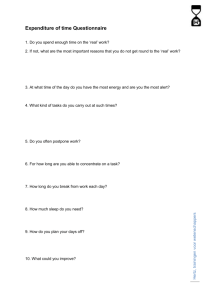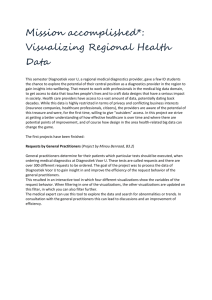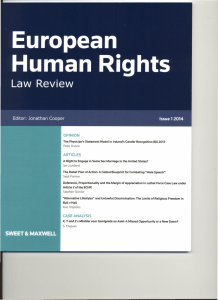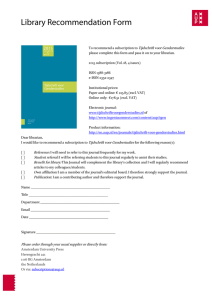do - Shenzhou
advertisement
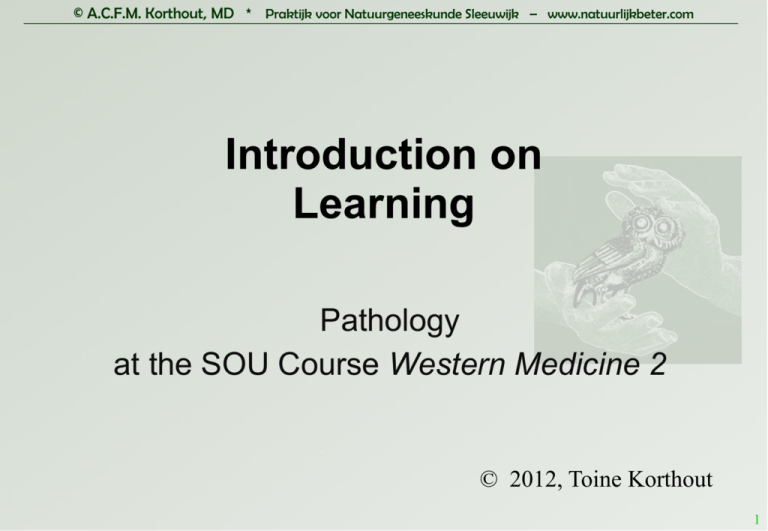
© A.C.F.M. Korthout, MD * Praktijk voor Natuurgeneeskunde Sleeuwijk – www.natuurlijkbeter.com Introduction on Learning Pathology at the SOU Course Western Medicine 2 © 2012, Toine Korthout 1 © A.C.F.M. Korthout, MD * Praktijk voor Natuurgeneeskunde Sleeuwijk – www.natuurlijkbeter.com Toine Korthout M.D. acupuncturist teacher www.natuurlijkbeter.com info@natuurlijkbeter.com 2 © A.C.F.M. Korthout, MD * Praktijk voor Natuurgeneeskunde Sleeuwijk – www.natuurlijkbeter.com program • • • • • • Aim of this introduction Learning Learning process Learning styles Feedback Personal Development Plan 3 © A.C.F.M. Korthout, MD * Praktijk voor Natuurgeneeskunde Sleeuwijk – www.natuurlijkbeter.com aim of this introduction Tuning in at learning (again) • This course WM2 requires a lot of study work • Students don’t study and learn all in the same way • This presentation aims to help you discover ways to optimalize your personal learning or make it easier 4 © A.C.F.M. Korthout, MD * Praktijk voor Natuurgeneeskunde Sleeuwijk – www.natuurlijkbeter.com learning cognition skill knowing things Being able to do things 5 © A.C.F.M. Korthout, MD * Praktijk voor Natuurgeneeskunde Sleeuwijk – www.natuurlijkbeter.com learning Reminding: 10% by hearing 35% by seeing 55% by hearing and seeing 70% by saying it yourself 90% by saying and doing it yourself 6 © A.C.F.M. Korthout, MD * Praktijk voor Natuurgeneeskunde Sleeuwijk – www.natuurlijkbeter.com learning That’s why classes pathology offer plenty opportunity … • to tell what you actually already know • to tell what you have studied • to tell what you do 7 © A.C.F.M. Korthout, MD * Praktijk voor Natuurgeneeskunde Sleeuwijk – www.natuurlijkbeter.com learning • Learning isn’t something for once only • Learning is linking new knowlegde and skills to previously achieved knowledge and skills • Learning is a continuous process 8 © A.C.F.M. Korthout, MD * Praktijk voor Natuurgeneeskunde Sleeuwijk – www.natuurlijkbeter.com learning process do, experience, act, try out, searching for information (I do and see what happens / how it’s going) check, implement concepts and theories, experiment actively (How would things be/go if …?) watch, analyse, observe how things are/were going (What do I see?) think, theorize, build concepts (How do things work?) 9 © A.C.F.M. Korthout, MD * Praktijk voor Natuurgeneeskunde Sleeuwijk – www.natuurlijkbeter.com learning process do, experience, act, try out, searching for information (I do and see what happens / how it’s going) check, implement concepts and theories, experiment actively (How would things be/go if …?) watch, analyse, observe how things are/were going (What do I see?) think, theorize, build concepts (How do things work?) 10 © A.C.F.M. Korthout, MD * Praktijk voor Natuurgeneeskunde Sleeuwijk – www.natuurlijkbeter.com learning process do check watch think One can enter the cycle at any average step One may have a preference to one of these four steps of the learning process 11 © A.C.F.M. Korthout, MD * Praktijk voor Natuurgeneeskunde Sleeuwijk – www.natuurlijkbeter.com learning process • As a student you may feel familiar with such a preference • The preference is often the step at which you tend to enter the learning cycle: • • • • doer? watcher? thinker? checker? 12 © A.C.F.M. Korthout, MD * Praktijk voor Natuurgeneeskunde Sleeuwijk – www.natuurlijkbeter.com learning styles Doer: • “What is the next step?” • “I just DO, and see where I get.” • Meaningfull words: • • • • • • motion renewal freedom do honesty action 13 © A.C.F.M. Korthout, MD * Praktijk voor Natuurgeneeskunde Sleeuwijk – www.natuurlijkbeter.com learning styles watcher: • “How do I look at this?” • “What have I seen? What do I actually already know?” • Meaningfull words: • • • • • • • time experience share balance meaning contemplation to process 14 © A.C.F.M. Korthout, MD * Praktijk voor Natuurgeneeskunde Sleeuwijk – www.natuurlijkbeter.com learning styles Thinker: • “What’s yet another view, approach?” • “Which other ways are there for me to get familiar with this?” • Meaningfull words: • • • • • • values overview clarity vision concepts perspectives 15 © A.C.F.M. Korthout, MD * Praktijk voor Natuurgeneeskunde Sleeuwijk – www.natuurlijkbeter.com learning styles checker: • “What do we want to reach?” • “What is it that I want to learn, to know, to be able to do?” • Meaningfull words: • • • • • • • background strategy of the context plan map system schedule pattern 16 © A.C.F.M. Korthout, MD * Praktijk voor Natuurgeneeskunde Sleeuwijk – www.natuurlijkbeter.com learning styles What is your predominant learning style? Mabe you already recognized it … With which one do you already feel familiar or safe? This test may help you to discover your predominant learning style: http://www.ldpride.net/learning-style-test.html engl http://vo.upnet.nl/content/tests/test_kolb1.php dutch 17 © A.C.F.M. Korthout, MD * Praktijk voor Natuurgeneeskunde Sleeuwijk – www.natuurlijkbeter.com learning styles Your predominant learning style On the basis of your (predominant) learning style you can determine your stronger and weaker points at learning/studying. You can take this into account at your study in this course. 18 © A.C.F.M. Korthout, MD * Praktijk voor Natuurgeneeskunde Sleeuwijk – www.natuurlijkbeter.com learning styles Doer • The Doer’s force is in ‘doing’. • His actions are goal-orientated, he can get along well with people and wants to achieve concrete results. • A Doer likes to get involved into a process and likes to work out plans practically. • In doing so, he orientates on information from other persons, rather than on own analytic capacities. • He is capable to adapt easily to specific and concrete situations. 19 © A.C.F.M. Korthout, MD * Praktijk voor Natuurgeneeskunde Sleeuwijk – www.natuurlijkbeter.com learning styles Optimal learning circumstances of a Doer: • Challengeing and exciting situations that demand choices • A lot of change in type of tasks • Opportunity for humour, pleasure and relaxation • Feedback on own actions • Atmosphere and contact are important • Mandate and freedom to quick reactions 20 © A.C.F.M. Korthout, MD * Praktijk voor Natuurgeneeskunde Sleeuwijk – www.natuurlijkbeter.com learning styles The Doer’s power •Serious worker •Ready to action •Enthousiasmising The Doer’s pitfalls •Does not get to implementation •Taking the wrong path •Overdue into action, ‘missing the train’ 21 © A.C.F.M. Korthout, MD * Praktijk voor Natuurgeneeskunde Sleeuwijk – www.natuurlijkbeter.com learning styles Tips for the Doer: • Get yourself clear targets and go purposely to work • Follow the path (yours and teacher’s) of subjects to be studied • Before you get into action: ask yourself wether it is a main or a side issue. • In any action: stand still a moment and decide wether you’re doing what really has to be done. • Try to achieve implementation 22 © A.C.F.M. Korthout, MD * Praktijk voor Natuurgeneeskunde Sleeuwijk – www.natuurlijkbeter.com learning styles Tips for a Doer for functioning well at classes, especially in co-operation with other students: • Participate actively in discussions • Act actively in praktical tasks • Draw, write and give practical presentations • Produce a schedule together with a Checker 23 © A.C.F.M. Korthout, MD * Praktijk voor Natuurgeneeskunde Sleeuwijk – www.natuurlijkbeter.com learning styles Watcher • A Watcher emphasizes concrete experiences and has a big imaginative power • His strength is the imagination and phantasy to observe from several points of view and to relate easily between different observations. • Watchers often are creative persons, who also need time and space to create ideas. 24 © A.C.F.M. Korthout, MD * Praktijk voor Natuurgeneeskunde Sleeuwijk – www.natuurlijkbeter.com learning styles Optimal learning circumstances of a Watcher: • Opportunity to express experiences and feelings • Time to process experiences • Opportunities to get familiar to the group and to exchange thoughts • Confrontation with various views and visions • Safe approach • Visual presentation of the subjects to be studied 25 © A.C.F.M. Korthout, MD * Praktijk voor Natuurgeneeskunde Sleeuwijk – www.natuurlijkbeter.com learning styles The Watcher’s power •Stand still •Ease and quiescence •Safe •Creative •Accurate •Reflective The Watcher’s pitfalls •Doesn’t get to action •Cannot get started •Sticks to introspection •Own frame of reference is too strong 26 © A.C.F.M. Korthout, MD * Praktijk voor Natuurgeneeskunde Sleeuwijk – www.natuurlijkbeter.com learning styles Tips for a Watcher: • Deal with the subjects to be studied in a creative way • Look for pictures, video’s etc related to the subjects • Try to imagine how subjects studied are • Dare to begin with a new subject • Dare to let loose your own vision at the subject • Dare to watch outside your well known frames • Dare just to start a (new) subject and to come into action 27 © A.C.F.M. Korthout, MD * Praktijk voor Natuurgeneeskunde Sleeuwijk – www.natuurlijkbeter.com learning styles Tips for a Watcher for functioning well at classes, especially in co-operation with other students: • Observe other students and tell them what you see • Observe the teacher • Be alert at visual presentations • Look for pictures that describe the subject, or mention it as a metaphore 28 © A.C.F.M. Korthout, MD * Praktijk voor Natuurgeneeskunde Sleeuwijk – www.natuurlijkbeter.com learning styles Thinker • A Thinker emphasizes in logical coherence among matter. • He wants do deal with building concepts and his biggest power is making theoretical models. • Logics, punctuality and thinking in clear abstract concepts predominates. • Thinkers try to argue towards reality from theoretical models. 29 © A.C.F.M. Korthout, MD * Praktijk voor Natuurgeneeskunde Sleeuwijk – www.natuurlijkbeter.com learning styles Optimal learning circumstances of a Thinker: • Clear goals and program • Oportunity to ask for the background • Confrontation with complex problems (considered to be challenging) • Order and tranquility • Time to deal oneself with the study subjects and placing them in their own frames 30 © A.C.F.M. Korthout, MD * Praktijk voor Natuurgeneeskunde Sleeuwijk – www.natuurlijkbeter.com learning styles The Thinker’s power •Wide scope •Arguing •Conceptualise •Overview The Thinker’s pitfalls •Can not decide •Sees too many objections •Sticks in details 31 © A.C.F.M. Korthout, MD * Praktijk voor Natuurgeneeskunde Sleeuwijk – www.natuurlijkbeter.com learning styles Tips for a Thinker: • Take your time for subjects to be studied • Put study subjects in a frame, a model, and search for its logics • Try to find the theory behind practice • Dare to question about the backgrounds • In case you don’t advance well, return a moment to the program, the list of tasks etc. • Dare to take some distance in order to get overview rather than seeing too many details 32 © A.C.F.M. Korthout, MD * Praktijk voor Natuurgeneeskunde Sleeuwijk – www.natuurlijkbeter.com learning styles Tips for a Watcher for functioning well at classes, especially in co-operation with other students: • Argue what you have seen in other students and what they made you aware of • Try to clarify things you get into • Share this all with others in headwords 33 © A.C.F.M. Korthout, MD * Praktijk voor Natuurgeneeskunde Sleeuwijk – www.natuurlijkbeter.com learning styles Checker • The Checker’s goal is to get to solutions and to technological application of concepts, models and theories. • He likes to face problems that need just one correct solution. • His prefered procedure is goal centered and methodical. 34 © A.C.F.M. Korthout, MD * Praktijk voor Natuurgeneeskunde Sleeuwijk – www.natuurlijkbeter.com learning styles Optimal learning circumstances of a Checker: • A clear line in matter to be studied • Oportunity to draw his own practical conclusions • Clear relation between subjects to be studied and own practice • Techniques and advises to solve problems independently • Competent teachers (who can do themselves what they teach) 35 © A.C.F.M. Korthout, MD * Praktijk voor Natuurgeneeskunde Sleeuwijk – www.natuurlijkbeter.com learning styles The Checker’s power •Making and keeping the speed •Achieves results •Realises motion •Summarize and ticking off The Checker’s pitfalls •Exclusively targeted at result •Panic in case of lack of structure •Rigidity in own patterns 36 © A.C.F.M. Korthout, MD * Praktijk voor Natuurgeneeskunde Sleeuwijk – www.natuurlijkbeter.com learning styles Tips for a Checker: • Look for the mainstream in subjects you study • Make summaries • Tick off what you have finished • Make a schedule of work to do • Ask for structure in case things are not clear enough for you • Dare to try ‘to think out of the box’, but try also to recognize the pattern in yet unknown fields 37 © A.C.F.M. Korthout, MD * Praktijk voor Natuurgeneeskunde Sleeuwijk – www.natuurlijkbeter.com learning styles Tips for a Checker for functioning well at classes, especially in co-operation with other students: • First mention how you would like to deal with things • Mention the structure and coherence you recognize • Support the group with logical sequences etc. • Summarize the contribution of others • Write down a summary together with a Thinker 38 © A.C.F.M. Korthout, MD * Praktijk voor Natuurgeneeskunde Sleeuwijk – www.natuurlijkbeter.com feedback 39 © A.C.F.M. Korthout, MD * Praktijk voor Natuurgeneeskunde Sleeuwijk – www.natuurlijkbeter.com feedback Feedback has several functions, such as: • It may help others to proceed • It may help to bring yourself and others readjustment and order • It may help to let off steam • It may help low point processes to get into motion again • All of this among students, but also between teacher and students (and in reverse) 40 © A.C.F.M. Korthout, MD * Praktijk voor Natuurgeneeskunde Sleeuwijk – www.natuurlijkbeter.com feedback At several moments ‘at pathology class’ you wil co-operate with in some way with fellow students: • Several settings of group work • Doing your presentation • Attending to someone else’s presentation 41 © A.C.F.M. Korthout, MD * Praktijk voor Natuurgeneeskunde Sleeuwijk – www.natuurlijkbeter.com feedback Feedback can be given • at evaluation moments • at moments where feedback is logically asked for explicitly • at moments where there is need for feedback • in that case especially to help along yourself or others 42 © A.C.F.M. Korthout, MD * Praktijk voor Natuurgeneeskunde Sleeuwijk – www.natuurlijkbeter.com feedback Playrules of feedback Any feedback is given in this way: I. I’ve seen/heared you doing [xxx] II. That had this effect on me: [yyy] / It provoked [yyy] in me III. It would have helped me a lot / you helped me a lot by [zzz] Nothing more and nothing less than that!! The one who gets feedback reacts with nothing but “Thank you”. 43 © A.C.F.M. Korthout, MD * Praktijk voor Natuurgeneeskunde Sleeuwijk – www.natuurlijkbeter.com personal development plan • The SOU course WM2 has targets to be achieved • The teacher offers education in a variety of subjects and tasks • The student gradually grows in knowledge and skills, following the curriculum • The student is the director and manager of his own development, based upon the education offered 44 © A.C.F.M. Korthout, MD * Praktijk voor Natuurgeneeskunde Sleeuwijk – www.natuurlijkbeter.com personal development plan Getting hold on your own development by using a personal development plan (PDP) : 1. What do I want to achieve / to be able to do [competence]? 2. Where am I right now [actual situation]? 3. What is needed to achieve what I want [subjects to be learnt]? 4. What, how, where and when am I going to do that [actions and their program]? 45 © A.C.F.M. Korthout, MD * Praktijk voor Natuurgeneeskunde Sleeuwijk – www.natuurlijkbeter.com personal development plan • Try to build your personal development step by step • Small steps keep your development accessible and do-able. • For that reason: ‘stay close to home’ and formulate your subjects to be learnt ‘smart’ … 46 © A.C.F.M. Korthout, MD * Praktijk voor Natuurgeneeskunde Sleeuwijk – www.natuurlijkbeter.com personal development plan Formulate your subjects to be studied as much as possible SMART: Specific • Know what you want to achieve Mesureable • Will your reality have been changed after reaching the goal? Acceptable • Let the goal be attractive and challenging to you Realistic • Make sure that the goal is really faesible Time related • Make sure that there is a realistic time table, without an open end 47 © A.C.F.M. Korthout, MD * Praktijk voor Natuurgeneeskunde Sleeuwijk – www.natuurlijkbeter.com personal development plan • You can use the four steps mentioned for a range of steps in your development • Write every step with 4 substeps on a sheet of paper or in a document • Create a folder in which you gather your personal development plan, by adding all your seperate steps 48 © A.C.F.M. Korthout, MD * Praktijk voor Natuurgeneeskunde Sleeuwijk – www.natuurlijkbeter.com sources • Website Vergouwen Overduin about learning styles: http://www.vergouwenoverduin.nl/testuzelf/test-leerstijlen • Honing M, Zwartkruis M. Pedagogischdidactische bekwaamheid voor docenten in het HBO. 2011, Nijmegen, Interstudie NDO 49

